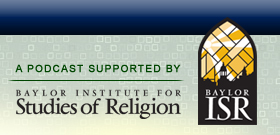

|
Jonathan Rose on Medieval Law and the Clergy  Date: January 24th, 2016
 How did common law develop in England? How is common law different than civil or canon law? And how did English clergy use the legal system to their benefit from the 13th to the 15th centuries? Professor emeritus Jonathan Rose of Arizona State University’s College of Law joins us to discuss these questions and many more. This interview is not only interesting for its connection to religion, but what one can learn about the development of a very “common” form of law and how legal institutions can be abused by various parties, including religious folk. Our conversation begins with some general discussion about being an emeritus professor and about how Prof. Rose came to study medieval English law. We then dive into some basic definitions of legal terms, most importantly covering the differences between common, civil, and canon law. Early in our discussion, we talk about the work of Richard Helmholz, an expert in the area of medieval English law (including canon law). It was an edited volume in honor of Prof. Helmholz’s work that Prof. Rose wrote his essay on the abuse of legal procedures by clergy. As common law develops in England throughout the medieval period, conflict ensues over the jurisdiction of the courts as relates to the clergy. Whereas there were a number of ecclesiastical courts that tried priests via canon law, the Church and its officials invariably interacted in the secular realm that brought it (and them) into contact with common law courts. Issues such as patronage, benefices, tithing, mortuary payments, land disputes, and even criminal misdeeds (e.g., rape) were often the subject of jurisdictional disputes between ecclesiastical and common law courts. Jonathan brings up the famous case of Thomas Becket as the best known example of such jurisdictional conflict that led to the murder of the Archbishop of Canterbury. We also discuss a number of areas where the Church had jurisdictional power over the general population — e.g., marriage, probate, religious offenses — that often created tension with secular authorities and their citizens. This is a great overview of how the multi-faceted legal profession operated back in the days of yore. The latter half of our discussion turns to the abuse of legal procedure. Here we learn that clergy were just as involved in the common law courts, and attempted to manipulate them to their advantage, just as the laity did. Prof. Rose explains the legal concepts of “maintenance” and “champerty.” Maintenance involves doing things in support of a lawsuit that one is not directly a party. Champerty was the worst type of maintenance in that it was expected that in exchange for help in litigation, an individual (or group) would receive some payment (or “part of the land”). One could imagine that this would lead to all sorts of machinations and conspiracies, and Prof. Rose points out that it certainly did and provides examples of such, including the noteworthy Eyre of Kent in 1293 wherein a group of priests were charged with conspiracy. Prof. Rose discusses how these abuses were eventually reined in beginning with Richard II. We conclude with some of Jonathan’s thoughts about how this history might teach us something of relevance in contemporary times. He notes that wherever there are legal rules, there will always be attempts to manipulate those rules. Recorded: January 12, 1016. RELATED LINKS Prof. Jonathan Rose’s bio at ASU’s College of Law. Prof. Jonathan Rose’s SSRN page (includes the article “Clergy and the Abuse of Legal Procedures in Medieval England”). Studies in Canon Law and Common Law in Honor of R.H. Helmholz, edited by Troy Harris. The Oxford History of the Laws of England, Volume I, edited by R.H. Helmholz. RELATED PODCASTS
One Response to “Jonathan Rose on Medieval Law and the Clergy”Leave a Reply |
 Search The Podcast
To search the podcast, type a term and click the Search button.
  Browse Podcast Categories
Select a category below to browse the podcast:
   |















[…] Jonathan Rose on Medieval Law and the Clergy. […]